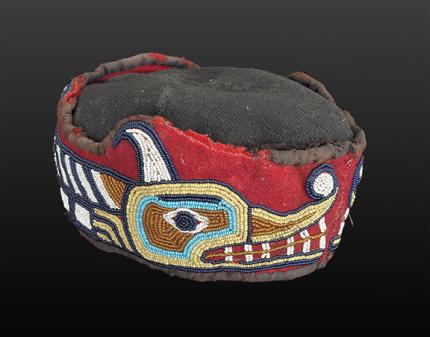
Beaded Head Ring/ Sisiutl Design
Kwakwaka'wakw, c. 1890
Trade cloth, glass beads
4 ¼ High
Custom tabletop display stand is included
In the 1890s, an interesting new piece of ceremonial regalia began to make its appearance among Kwakwaka'wakw ritualists. Certain styles of traditional headgear predate this type and probably influenced its development. These include the elaborate kinds of finely worked cedar-bark headrings that were made in this period and earlier, as well as elaborately carved, painted, and pieced-together wooden constructions that featured a range of individual family crest images in dramatic and flamboyant styles.
This finely beaded, red trade-cloth example is composed with the design of a Sisiutl, the double-headed serpent that appears in many different forms and image styles in the Kwakwaka'wakw ceremonial tradition. The Sisiutl design was often associated with warriors and warrior imagery. Its flesh was impenetrable, it could cause instant death with a glance, and those who looked upon it were said to be turned to stone. The Sisiutl often appears on headpieces, wooden belts and dance paraphernalia, feast dishes, totem poles, and canoe designs.
The double-headed serpent is often shown as it appears here, with a central face and two opposing profile bodies and heads, suggesting a three-headed creature. On totem poles, the central head is often at the bottom of the image, with each profile body and head extending up the pole on either side, suggesting that the two profile sides are the split halves of a single, second body and head. In images like the one on the subject work, the split halves of the double-headed serpent are opened out into the two profile sides that here wrap around the wearer?s head.
This style of headpiece appears not to have continued in production into much of the twentieth century, as few examples seem to have survived. Photographs from the 1950s and 60s, the first decades of the potlatch revival period, don?t include headpieces of this kind, suggesting that the heyday of this style of headgear spanned the last decades of the nineteenth century and perhaps the earliest years of the twentieth.
- Steven Clay Brown
former curator of Native American art at the Seattle Art Museum who has authored several books on Northwest Coast art, as well as articles and essays for many other publications.
